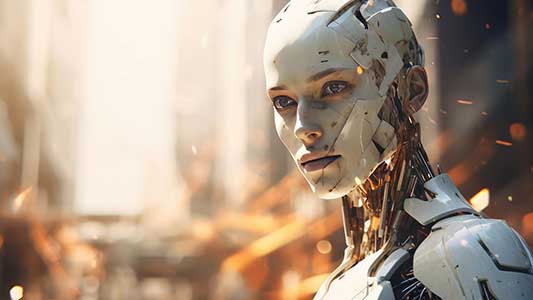The humanoid robot industry is revolutionizing the landscape of automation by combining advanced technology with human-like functionalities. As artificial intelligence and robotics advance, humanoid robots are becoming more important in healthcare, education, entertainment, and customer service. These advanced robots are designed to emulate human movements and interactions, improving efficiency and redefining human-robot collaboration. With rapid growth in the sector driven by innovation and the rising demand for personalized robotic solutions, the future of humanoid robots anticipates exciting developments and significant impacts in various industries. As per the recent report published by Allied Market Research, the humanoid robot market is predicted to cite a notable CAGR of 7.7% during the forecast period.
The evolution of humanoid robots
Artificial intelligence and machine learning
AI and machine learning have enabled humanoid robots to execute complex tasks, acquire knowledge from their surroundings, and enhance their performance gradually. A prominent example of this is Sophia, developed by Hanson Robotics. By utilizing AI, Sophia can recognize faces, understand and interpret speech, and engage in natural conversations. She can express a wide range of emotions and is designed to learn from her interactions. Sophia’s adaptable abilities have been utilized in various fields such as customer service, healthcare, and education. Furthermore, she has showcased her conversational skills at multiple conferences and on television.
Advanced sensors and perception systems
Modern humanoid robots are equipped with a variety of sensors, such as cameras, LIDAR, and tactile sensors that help them understand their surroundings with precision. For example, Atlas by Boston Dynamics features stereo vision, range sensing, and advanced algorithms that enable it to handle rough terrain, maintain balance, and perform complex movements such as backflips and parkour. Because of these capabilities, Atlas is used in various applications, such as disaster response, search and rescue operations, and other situations that require robust mobility.
Natural language processing
In robotics, natural language processing (NLP) plays a key role in enabling machines to accurately understand human language, providing more precise and contextually relevant responses. A notable example of this is SoftBank Robotics’ Pepper, which showcases the potential of NLP. Pepper can understand and respond to queries in multiple languages and recognize human emotions, thus ensuring personalized and responsive interactions. This advanced technology is widely used in industries such as retail, hospitality, and healthcare, where its skills in interacting with customers enhance overall experiences and establish a new standard in human-robot communication.
Dexterous manipulation
The advancement of robotics has stimulated the evolution of humanoid robots, like Honda’s ASIMO. ASIMO shows impressive capabilities, including graceful walking, running, and effortlessly climbing stairs. What sets it apart is its remarkable precision in handling objects. This precision is enabled by its complex hands, capable of executing delicate manipulation tasks. ASIMO has numerous features. It represents innovation and suggests a future where robots seamlessly integrate into people’s daily routines, offering assistance as needed.
Robotic exoskeletons and assistive technologies
Cutting-edge technologies such as ReWalk by ReWalk Robotics are transforming healthcare and rehabilitation by enhancing human capabilities. ReWalk is a type of exoskeleton designed to assist people with lower limb disabilities in walking, standing, and turning by utilizing powered hip and knee movements. This technology can be used in rehabilitation centers as well as in the everyday lives of individuals with spinal cord injuries, providing them with improved mobility and a significant enhancement in their overall quality of life.
NVIDIA introduces project GR00T Foundation Model for humanoid robotics and extensive upgrade to Isaac robotics platform
In March 2024, NVIDIA introduced Project GR00T, an innovative program focused on enhancing the capabilities of humanoid robots through advanced AI technology. In addition, the introduction of Jetson Thor, a high-performance computing system designed specifically for humanoid robots, streamlines the development and integration process. By collaborating with top robotic firms, NVIDIA’s upgrades to the Isaac platform offer revolutionary advancements in embodied AI, granting robots increased agility and perception. This represents a significant development in robotics, forming a new era of AI-driven innovation and collaboration.
Tesla’s Optimus Gen 2 emerges as the next generation of robotic technology
In December 2023, Tesla launched the latest version of its humanoid robot series, Optimus Gen 2, with an engaging demo video. Unlike the previous models, Bumblebee and Optimus Gen 1, which had unstable movements and limited abilities, the new version shows significant advancements. The promotional video highlights the modern design and impressive functions, generating excitement among viewers eager to witness the robot’s capabilities. With improved stability and enhanced features, Optimus Gen 2 represents a notable advancement in Tesla’s development of humanoid robots, opening new opportunities for applications in various industries.
To conclude, the rapid evolution of humanoid robots, driven by advancements in artificial intelligence, sensor technology, and human-robot interaction, is having a significant impact on industries worldwide. Furthermore, new initiatives such as NVIDIA’s Project GR00T and Tesla’s Optimus Gen 2 are driving more revolutionary advancements in the future, offering lucrative opportunities for industry growth in the coming years.
Short Description:
The rise of humanoid robots is revolutionizing various industries, fueled by cutting-edge technologies such as artificial intelligence, advanced sensors, and natural language processing. Hanson Robotics’ Sophia and Honda’s ASIMO have showcased remarkable capabilities in healthcare and customer service, while companies like NVIDIA and Tesla continue to make notable advancements with transformative impacts worldwide.
𝑨𝒓𝒕𝒊𝒄𝒍𝒆 𝒘𝒓𝒊𝒕𝒆𝒓: Harshada Dive Author’s Bio: – Harshada Dive is a computer engineer who loves to experiment with trending topics and is passionate about presenting these topics creatively to her audience. When Harshada’s not writing, she is either gardening or listening to inspirational podcasts.












